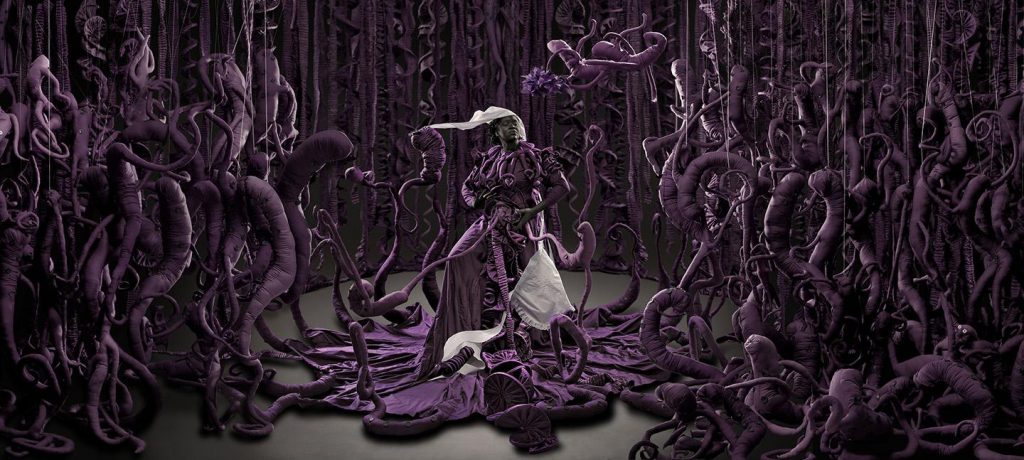Just off the main entrance of Somerset House, you enter a room where time moves more slowly than the place from which you came. Two silhouettes in the distance metamorphose into distinct figures, chaotically draped in full-skirted gowns – one in royal blue ruffles with dashes of stark white linen, the other chaotically adorned in hues of pink and purple and placed slightly off kilter, her hands straining for balance. Dozens of thick tentacles, belonging to the octopus which has seemingly engulfed half of her body, envelop most of her width. Suspended in the air above her are dozens more of these cloth-made sea creatures, threatening to swarm her at any moment.
These are mannequins, of course, but the dim lights and the low growls emanating from the room just behind it puncture any air of ‘festive cheer’ that you may remember from the ice-skating rink or golden tinsel just outside.
This was my first glimpse of Mary Sibande’s exhibition I Came Apart at the Seams. Even before knowing anything about it and discovering it basically by accident, the ambiance immediately made clear that the vibrant sculptures and powerful photographs spoke bounds in support of empowerment, agency and resistance.
The placards on the walls explain that Sibande is a South African artist who imagines herself as the avatar Sophie, transforming through her historical journey as some sort of alter-ego. She utilises the figure of Sophie to comment on South African modern life and history, exploring revolution, injustice, blackness and femininity in the process.
In the first room, Long Live the Dead Queen, there’s a deep personal and political protest rippling out of the intricately designed textures of the gowns, also echoed in the second room ‘A Reversed Retrogress’. The blue gown depicts a domestic worker’s uniform and clothes both the model of Sibande and the woman pictured in the second room, where there is an additional superwoman emblem embroidered into it within the frame.
Sibande ties together the modern and historical socio-political dynamics of South Africa, as well as her family’s legacy – it encapsulates a representation of her mother, grand-mother and great-grandmother who were all forced to perform domestic labour. Their gestures and costumes critique stereotypical representations and narratives of South-African women and invert colonialist depictions of power as they demand space and attention.
The third room lulls you into its haunting arms. You are led to gaze, entrapped, at another transformation of the avatar barred from a pose of seeming escape through tree-like roots behind her, which also allude to the same octopus tentacles seen in the room before. Sibande uses colour to signal transition and change and, while the blue costume symbolise inequality and the confinements of domestic life, the purple shows the struggle against apartheid; this is deliberately suggested through the forces of nature which the sea-life suggests, as the obscured body is bursting from its clutches, resiliently frozen in a perpetual state of resistance. The Purple Shall Govern refers to the 1989 Purple Rain protest in Cape Town where protesters were sprayed with purple dye by police.
Finally, the room is coloured angry in The Red Figure, as the painting expresses a “collective disillusionment” with the unfulfilled promises of equality post-apartheid. Here, Sophie represents a wilful empowerment to rise up against current injustices, fuelled by the encouragement of the anti-apartheid legacy and struggles which came before her. Pictured being pulled by what appear to be venomous-looking pitbulls, Sophie’s final transformation as a healer and a priestess is the answer to contemporary post-colonialist injustice: continued and unapologetic resistance.I Came Apart at the Seams is an incredibly captivating exhibition which I’m so very lucky to have discovered. If you’re more cultured than I am and have already heard about it elsewhere, don’t wait for a spontaneous visit to the Strand to go see it- it’s completely free and is also Sibande’s first solo exhibition in the UK. Not only is the message as powerful as the talented artistry, her intermingling uses of colours, textures, forms, gestures, lighting and even sound usurp the ‘simpler’ designs of many modern artworks. Above all, Sibande demonstrates how imagination can be a forceful authority when it is embodied with as much meaning as she manages to depict.



